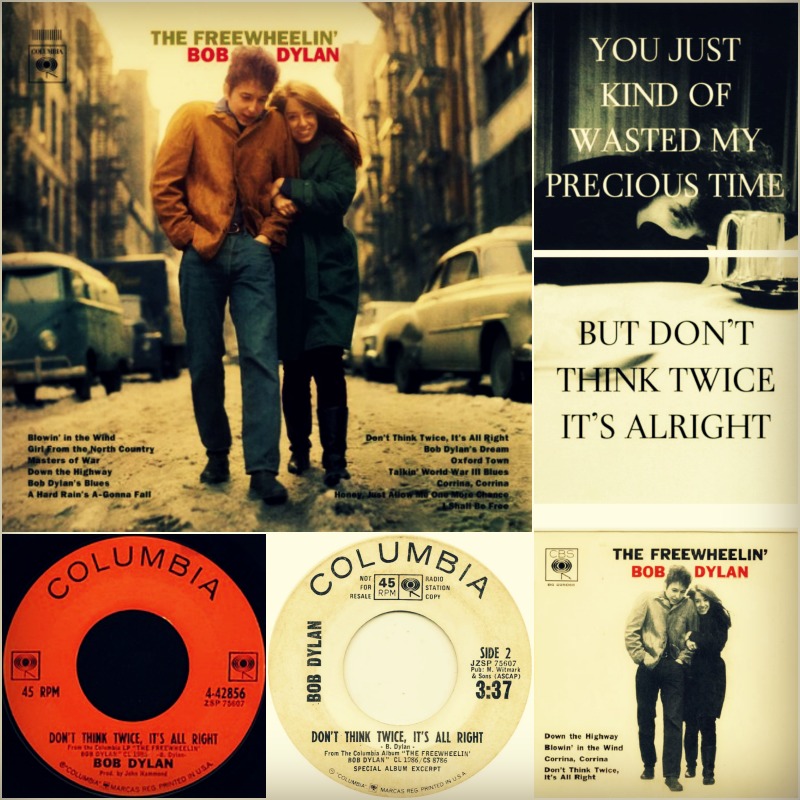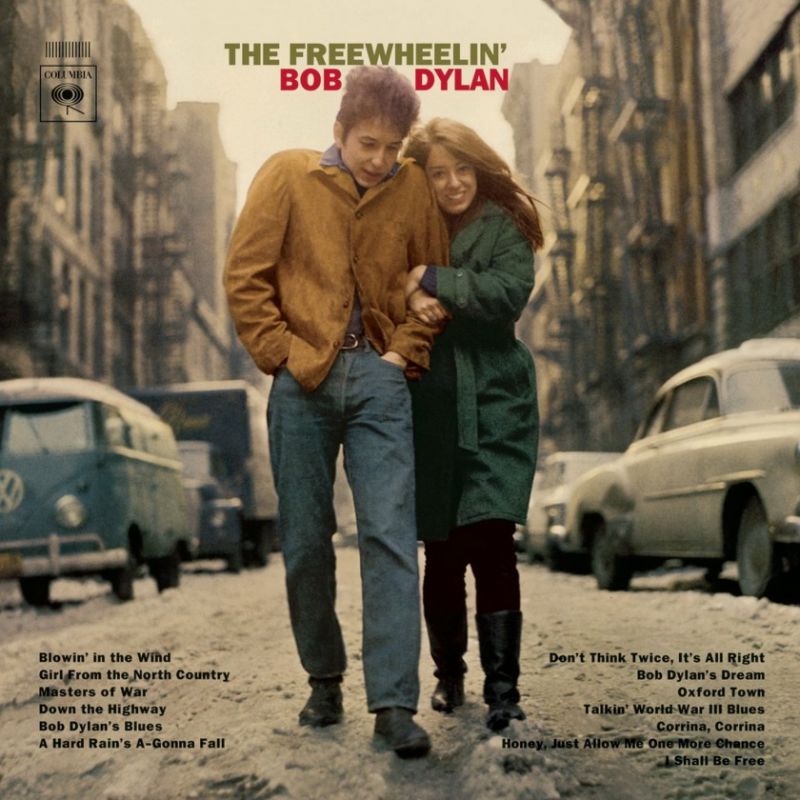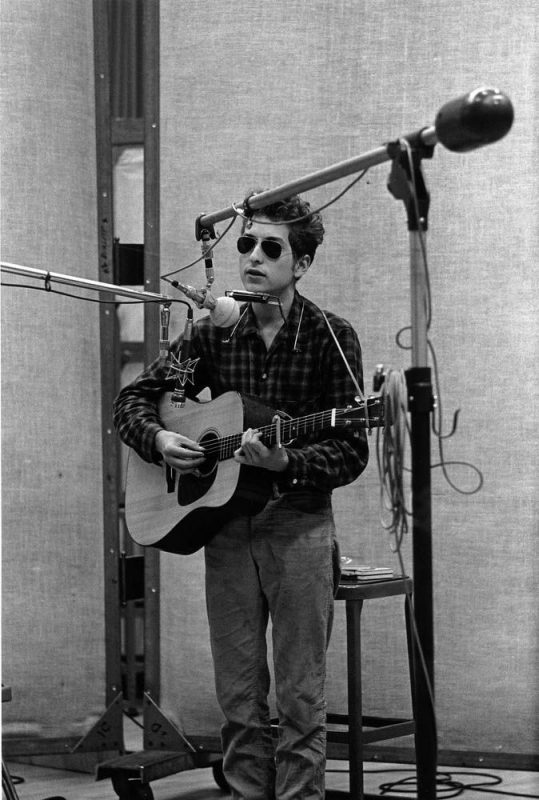
TOC
@#35 on my list of Bob Dylan’s top 200 songs.
Facts

Wikipedia:
It was written around the time that Suze Rotolo (girlfriend) indefinitely prolonged her stay in Italy.
The melody is based on the public domain traditional song “Who’s Gonna Buy Your Chickens When I’m Gone” and was taught to Dylan by folksinger Paul Clayton, who had used it in his song “Who’s Gonna Buy You Ribbons When I’m Gone?”
Studio recording:
Studio A
Columbia Recording Studios
New York City, New York
14 November 1962
The 6th Freewheelin’ Bob Dylan session, produced by John Hammond.
1 take.
Musicians:
- Bob Dylan
Live:
- First known performance: Gaslight Café, New York City – October 15, 1962
- It has been performed 1034 times live – last performance: Christchurch, New Zealand, Horncastle Arena – August 28, 2018
- Top year 1999 with 51 performances
Quotes
“Don’t Think Twice, It’s All Right” is a masterpiece.. [it’s] about the transmuting of pain into something not only bearable but actually attractive. We could call it”cool” but it’s a lot deeper than that. The singer of the song conveys a tremendous dignity, and an authentic lightness, even while also communicating pain, bitterness, confusion, and more than a hint that he would get down on his knees and beg if he thought it’d do any good. He also communicates love. There is no “way” to put all this into a simple song, four verses, that can be understood and sung by anyone. Dylan has done it through a combination of luck (you hit on a clever phrase, just like a country music songwriter, and all of a sudden a whole song drops into your lap), mastery, and conviction.
-Paul Williams (Bob Dylan Performing Artist I: The Early Years 1960-1973)
Dylan’s studio recording of “Don’t Think Twice, It’s All Right” rep- resents one of the most perfect fusions of tune, lyric, vocal, and musical performance in the man’s forty-five years as a recording artist. And he achieved it all in a single take. As perfect in its own, concise way as more ostentatious classics from more mature albums, “Don’t Think Twice” also stands as one of his more contentious works. The song owes interrelated debts to Paul Clayton and Bruce Langhorne (for its tune and accompaniment, respectively), neither readily acknowledged at the time. Only when those pesky biographers began picking at Bob’s biographical bones did a suspicion grow that this sublime song should perhaps have credits that read, “Dylan, arr. Clayton-Langhorne.”
– Clinton Heylin – Revolution in the Air: The Songs of Bob Dylan, 1957-1973
A couple of lines are strongly inspired by Paul Clayton’s “Who’s Gonna Buy You Ribbons (When I’m Gone).” Clayton himself was inspired by the traditional Appalachian song “Who’s Gonna Buy You Chickens (When I’m Gone).” Dylan uses an identical phrase to start most of his stanzas: “Ain’t no use to…” from Clayton’s song, “It ain’t no use to…” This similarity led to a lawsuit for plagiarism, resulting in a generous compensation for Clayton shortly before the two folksingers, reconciled, toured together in February 1964. Interestingly enough, when Johnny Cash’s “Understand Your Man” was released in January 1964, a title that has a real melodic similarity to “Don’t Think Twice, It’s All Right,” no plagiarism was mentioned. Music, like most art, is a form of emotional expression transmitted to the community, expression fed by a common heritage accessible to all and enriching the collective unconscious. Hence, how much popular music was inspired by the greatest standards of jazz, blues, classical, rock, or folk? Dylan is often accused of having plundered a particular artist, but even if it is true that he finds inspiration in other artists, his immense talent makes all the difference. He transforms the borrowed material and assimilates it into new creations. Not only Dylan, but John Lennon, Jimmy Page, Duke Ellington, Ludwig van Beethoven, and many others have done the same thing. But who can compete with them? “Don’t Think Twice, It’s All Right” shows all the creative force of Dylan, who owes nothing to anyone except himself. It was recorded in one take on November 14, 1962, and Dylan once again demonstrates his great power of concentration in the studio.
-Margotin, Philippe; Guesdon, Jean-Michel. (Bob Dylan All the Songs: The Story Behind Every Track)
An almost perfect song – tender, deceptively simple yet very clever. Looking at Dylan’s whole catalogue, it is songs like this, perhaps, that have the best chance of enduring through the decades, even through the centuries, partly because “Don’t Think Twice, It’s All Right” is not tied to social issues and will never date.”
-Howard Sounes (Author of “Down the Highway: The Life of Bob Dylan”)
With Dylan you’ve got a really brilliant writer of wonderful, well-crafter songs, somebody who loves language. The lyrics possess beautiful, powerful imagery. “When your rooster crows at the break o’dawn, look out your window and I’ll be gone” – that’s so bluesy.
-Bryan Ferry (from: Uncut Magazine – Bob Dylan’s 40 best songs)
In 1962, Dylan was heartbroken after Suze Rotolo, his first serious girlfriend, left New York for an open-ended stay in Italy. Out of that pain came this classic breakup ballad, in which he reels from a desperate sense of abandonment to a sharp bitterness (“You just kinda wasted my precious time”). “It isn’t a love song,” he wrote in the liner notes to The Freewheelin’ Bob Dylan. “It’s a statement that maybe you can say to make yourself feel better. It’s as if you were talking to yourself.” Dylan borrowed the song’s melody from folk singer Paul Clayton (who had himself adapted it from the earlier tune “Scarlet Ribbons for Her Hair”), later settling out of court when Clayton filed a claim against him. But a poultry supplier near Dylan and Rotolo’s former Greenwich Village apartment inspired one key image: “When your rooster crows at the break of dawn/Look out your window, and I’ll be gone.” As Rotolo recalled in her 2008 memoir, “When Bob and I stayed up all night … we heard the roosters crowing at the break of dawn.”
-Rollingstone.com (100 Greatest Bob Dylan Songs)
Lyrics
It ain’t no use to sit and wonder why, babe
It don’t matter, anyhow
An’ it ain’t no use to sit and wonder why, babe
If you don’t know by now
When your rooster crows at the break of dawn
Look out your window and I’ll be gone
You’re the reason I’m trav’lin’ on
Don’t think twice, it’s all right
It ain’t no use in turnin’ on your light, babe
That light I never knowed
An’ it ain’t no use in turnin’ on your light, babe
I’m on the dark side of the road
Still I wish there was somethin’ you would do or say
To try and make me change my mind and stay
We never did too much talkin’ anyway
So don’t think twice, it’s all right
It ain’t no use in callin’ out my name, gal
Like you never did before
It ain’t no use in callin’ out my name, gal
I can’t hear you anymore
I’m a-thinkin’ and a-wond’rin’ all the way down the road
I once loved a woman, a child I’m told
I give her my heart but she wanted my soul
But don’t think twice, it’s all right
I’m walkin’ down that long, lonesome road, babe
Where I’m bound, I can’t tell
But goodbye’s too good a word, gal
So I’ll just say fare thee well
I ain’t sayin’ you treated me unkind
You could have done better but I don’t mind
You just kinda wasted my precious time
But don’t think twice, it’s all right
Live versions
Town Hall
New York City, New York
12 April 1963
–
Town Hall
Birmingham, England
5 May 1965
- Bob Dylan (guitar, harmonica & vocal)
–
Feijenoord Stadion
Rotterdam, The Netherlands
23 June 1978
- Bob Dylan (vocal & guitar)
- Billy Cross (lead guitar)
- Alan Pasqua (keyboards)
- Steven Soles (rhythm guitar, backup vocals)
- David Mansfield (violin & mandolin)
- Steve Douglas (horns)
- Jerry Scheff (bass)
- Bobbye Hall (percussion)
- Ian Wallace (drums)
- Helena Springs, Jo Ann Harris, Carolyn Dennis (background vocals)
Video starts @ 29s
–
Zirkus Krone
München, Germany
21 June 1991
- Bob Dylan (vocal & guitar)
- John Jackson (guitar)
- Tony Garnier (bass)
- Ian Wallace (drums)
Here’s a song about … Sometimes, like just today, somebody was coming to my hotel and stopped me on the street and he grabbed me around the shoulders and said “Mr. Zimmerman!” (pronounced with thick German accent!) These kind of things kind of shake a person up sometimes. And long ago somebody said the same thing. He didn’t know me and he got run over by a street-car, in the middle of the street. It was a sad thing, but there wasn’t anything for me to do but go back and write this song. And after it was written, that’s when it was sung.
~Intro to this version of Don’t Think Twice
–
Voorst Nationaal
Brussels, Belgium
23 March 1995
- Bob Dylan (vocal & guitar)
- Bucky Baxter (pedal steel guitar & electric slide guitar)
- John Jackson (guitar)
- Tony Garnier (bass)
- Winston Watson (drums & percussion)
Copa Room
Sands Casino
Atlantic City, New Jersey
27 February 1999
Early show
- Bob Dylan (vocal & guitar)
- Bucky Baxter (pedal steel guitar & electric slide guitar)
- Larry Campbell (guitar)
- Tony Garnier (bass)
- David Kemper (drums & percussion)
–
La Malagueta Bull Ring
Málaga, Spain
17 April 1999
- Bob Dylan (vocal & guitar)
- Bucky Baxter (pedal steel guitar & electric slide guitar)
- Larry Campbell (guitar)
- Tony Garnier (bass)
- David Kemper (drums & percussion)
–
Madison Square Garden
New York City, New York
30 June 1999
Eric Clapton & Friends To Benefit Crossroads Centre Antigua
- Bob Dylan (vocal & guitar)
- Eric Clapton (guitar)
- Andy Fairweather Low (guitar)
- Nathan East (bass)
- Tim Carmon (keyboards)
- Steve Gadd (drums)
–
Aberdeen Exhibition & Conference Centre
Aberdeen, Scotland
16 September 2000
- Bob Dylan (vocal & guitar)
- Charlie Sexton (guitar)
- Larry Campbell (guitar, mandolin, pedal steel guitar & electric slide guitar)
- Tony Garnier (bass)
- David Kemper (drums & percussion)
–
Manchester Evening News Arena
Manchester, England
9 May 2002
- Bob Dylan (vocal & guitar)
- Charlie Sexton (guitar)
- Larry Campbell (guitar, mandolin, pedal steel guitar & electric slide guitar)
- Tony Garnier (bass)
- Jim Keltner (drums & percussion)
–
Queens Wharf Events Centre Arena
Wellington, New Zealand
24 February 2003
- Bob Dylan (vocal & guitar)
- Bill Burnette (guitar)
- Larry Campbell (guitar, mandolin, pedal steel guitar & electric slide guitar)
- Tony Garnier (bass)
- George Recile (drums & percussion)
–
Globe Arena
Stockholm, Sweden
28 March 2007
Musicians:
- Bob Dylan (guitar)
- Stu Kimball (guitar)
- Denny Freeman (guitar)
- Donnie Herron (violin, mandolin, steel guitar)
- Tony Garnier (bass)
- George Recile (drums & percussion)
–
Cover Versions
Elvis Presley
–
Johnny Cash – Newport 1964
–
Merle Haggard & Willie Nelson:
–
Waylon Jennings:
–
Peter, Paul & Mary:
–
Dolly Parton:
–
Joan Baez:
–
Bryan Ferry (Live 2003):
–
The Allman Brothers Band w/Susan Tedeschi (Live 2004):
–
–
Sources
- Bob Dylan – The Lyrics: Since 1962
- Philippe Margotin & Jean-Michel Guesdon – Bob Dylan All the Songs: The Story Behind Every Track
- Clinton Heylin – Revolution in the Air: The Songs of Bob Dylan, 1957-1973
- Paul Williams – Bob Dylan Performing Artist I: The Early Years 1960-1973
- Uncut Magazine – Bob Dylan’s 40 best songs
- RollingStone Magazine – 100 Greatest Bob Dylan Songs
- Wikipedia
- Olof’s – Still On The Road
- bobdylan.com
-Egil


egil…so glad u are back on…namely sending Dylan blogs…. have missed them…keep up the good work and also “take it easy!”
Thanks windywood, I’ll try to post more regularly. Fuel for my soul to compile these Dylan posts… indeed it is.
No Dylan composition and performance moves me more than the Freewheelin’ album recording of Don’t Think Twice. Mr. Dylan’s voice and vision… along with Bruce Langhorne’s guitar playing on this particular song, changed my life. PS: in a good way!
Great comment, thanks CalypsoJimmy.
Great post about a great song!
Thanks.